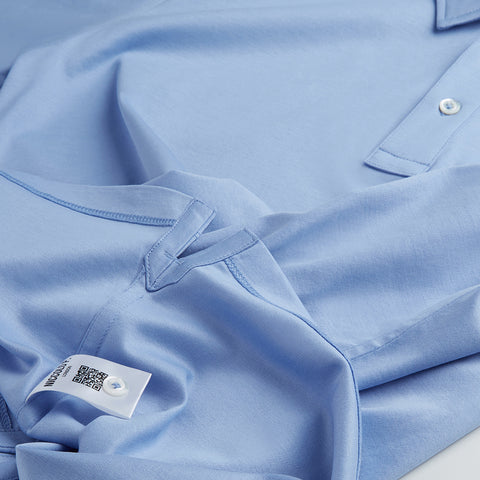The Ultimate Polo Shirt Guide [2024 Update]
The polo shirt is nearly 100 years old and wearing one well is simply a case of buying the colour you like and putting it on, right? Wrong! There are many aspects to the classic polo which can change its suitability for different occasions. To help you in your search for the perfect polo shirt in 2024 we have updated our comprehensive guide to polo shirts which outlines all of the key parts of polo shirt design. So, what should you look for in the perfect polo shirt?

Shape and Fit
Fit is undoubtedly the most important aspect of polo shirt design. Many heritage brands still rely on patterns and shapes which are decades old and thus based on outdated body shapes. It is important to identify brands which employ a contemporary approach to fit: ideally giving a natural fit which is neither slim nor boxy (depending on your preferences of course). Other aspects to the perfect polo shirt fit include:
Sleeve length: The sleeve should be designed to reach to mid-bicep, to show just enough arm
Arm holes: The design of the arm holes is crucial to ensure a good drape to the polo. When you try on a polo shirt, ask yourself: ‘Does this fit like a favourite jacket?’ If the answer is ‘no’, you should keep looking
Placket: There are several different types of placket found on polo shirts. The highest quality version is known as the ‘set-on’ placket – it is made from a separate piece of fabric and is considerably more complicated to manufacture but it gives the shirt a more defined, classical appearance. The placket should generally come with no more than three or four buttons as this gives the ideal length so that the polo shirt looks great buttoned up or partially unbuttoned
Hem split: The best polo shirts will have a split (generally no more than an inch) given to the hem to help ensure an even fit around the waist. There should be no extended/tennis tail as these are better suited to sports polos

Mother-of-Pearl Buttons
The hallmark of all high-quality shirts and polo shirts. Unfortunately, many name brand polos now use plastic or imitation mother-of-pearl buttons – neither has the same iridescence or longevity of genuine mother-of-pearl. The very best mother-of-pearl buttons are sourced from the Australian species Pinctada Maxima (known as the largest and rarest pearl oysters). These buttons can be dyed to match specific Pantone colour references so that they match the body of the shirt.

Fabric Weight
Choosing the right weight of fabric for any garment is part art/part science. There are several factors to take into account such as the knit or weave of the fabric (including how open or closed it is) and during which season(s) the shirt will be worn.
For piqué knits, a fabric weight of 200-220 grams per square metre is perfect for wear from Spring through Autumn. For jersey knits, a slighter lighter weight (around 170-190 grams per square metre) is recommended. If a brand does not list the cotton weight used it may very well be that they are using a lighter (read: cheaper) fabric.
Pristine Seams
The very best polo shirts are sewn using a flat felled seam. Although this adds considerable expense, it makes the garment more durable and less likely to lose its shape. It also makes the inside of the polo neater and, we believe, more comfortable to wear. So well made, in fact, that it could almost be worn inside out.

Mercerised Finish
Mercerisation is a treatment that gives fabric (or yarn) a bright, lustrous appearance while also strengthening it and improving colour-fastness. For these reasons, you should choose mercerised where possible – this will generally only be found on higher quality polos.
Stand Collars and Interlining
A stand collar gives shape and height to a polo shirt collar meaning it doesn't sit flat around the neck/collar bone area. For this reason, if you plan to wear your polo under tailoring (and many do), you should ensure you buy a polo shirt with a stand collar.
A key problem with many polo shirts are collars which curl (the so-called 'bacon curl' effect which looks unkempt even if you aren't) and remain difficult to iron through the life of the shirt. This can be avoided by choosing a collar which has the right amount of interlining (a fabric which sits inside the collar and adds stiffness). Interlining which has been added to both sides of the collar should prevent curling at the points - although it is important that the collar is not so stiff as to feel like a formal shirt.
Logo or No Logo?
Whether you choose a polo shirt with a logo or not is a matter of personal preference. Logos can be embroidered in contrasting thread or, more discreetly, tone-in-tone to match the colour of the shirt. As a general rule, we prefer our clothing to have minimal or no logos at all - quality can (and usually does) speak for itself.
Tennis Tail
A tennis tail is an extended flap of fabric at the back of the polo shirt. This style is very much aimed at the sportswear market - as such, only buy if you intend to use the polo shirt for your sporting endeavours.
Other Finer Details
In this essential guide to the perfect summer polo shirt we’ve shown how many aspects to polo shirt design are important to the finished garment. Additional smaller details to look out for include buttons which have been sewn using a crow’s foot (or fleur-de-lis) stitch. This is both decorative and functional as it reduces the likelihood of the button thread unravelling during washing cycles.
At Niccolò P. we set out to make polo shirts which are more structured than most. We marry the highest quality materials in the world with bespoke-like details to give you the best of all worlds.
